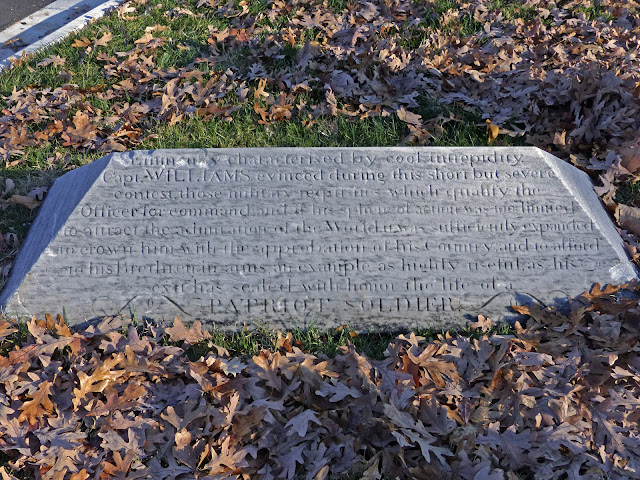Here Lie the Remains of JOHN WILLIAMS late a Captain in the Corps of U. S. Marines. Was born in Stafford County Virginia the 24th August 1763 and died on the 29th September, 1812, at Camp New Hope, in East Florida.And continues on to tell the story of the ambush at Twelve Mile Swamp on Sept. 11, 1812.
On the 11th September 1812, Capt. WILLIAMS on his march with a Command of 20 Men to Davis Creek Block House in East Florida, was attacked toward evening by upwards of 50 Indians & Negroes, who lay concealed in the woods. He instantly gave battle; gallantly supported by his Men who, inspired by his animating example, fought “as long as they had a cartridge left.” At length, bleeding under eight galling wounds and unable to stand, he was carried off the battle ground, whilst his heroic little Band, pressed by superior numbers was forced to retreat.
Eminently characterised by cool intrepidity Capt. WILLIAMS evinced during this short by severe contest, those military requisites which qualify the Officer for command and if his sphere of action was too limited to attract the admiration of the World, it was sufficiently expanded to crown him with the approbation of his Country; and to afford to his Brethren in arms, an example as highly useful, as his exit has sealed with honor the life of a PATRIOT SOLDIER.
The body of the deceased was removed to this spot over which his Brother Officers of the Marine Corps have caused this Pile to be erected in testimony of his worth, and of their mournful admiration.
In the year 1811, Marines commanded by Captain John Williams operated with the Navy, Army, and Georgia volunteers in East Florida, participating in the so-called Patriots' War. Although Florida was at the time a Spanish possession, the United States Government feared that Great Britain was about to take possession of East Florida. The situation was complicated by the fact that our non importation laws had resulted in a considerable smuggling trade of British goods from East Florida into Georgia. Amelia Island, off the coast of Florida, was being used as the major haven for the smugglers.
Marines escorting a convoy of supply wagons ambushed by an irregular force of Native Americans and African Americans in Twelve Mile Swamp near St. John's, East Florida, 11 Sep. 1812 . Marine Corps KIA 2, Marine Corps WIA 7.
Here's Waterhouse's map locating the 12 Mile Swamp, Davis Creek blockhouse and the St. John's river.
Captain Williams described his wounds in a letter to his commanding officer, Lieut. Col. F. Wharton. “My right leg is broke, my right hand shot through with three balls, my left arm broke, my left leg shot through, a ball in my left thigh, near the groin; another through the lower part of my body, which renders me altogether helpless.” He ends his letter on this up-beat note. “You may suppose that I am in a dreadful situation, though I yet hope I shall recover in a few months.”
Major McClellan says that when Williams died on Sept. 29 he became the second Marine Corps officer killed in action since the American Revolution. (McClellan, footnote 40.) Marine officers were ordered by Lt Col. Wharton to wear black crepe on their left arm and on the hilt of their swords for a month in honor of Captain Williams. (See McClellan, footnote 41.)
Waterhouse ends his vivid verbal description of the action with this reflection.
The ambush in Twelve-Mile Swamp and Marine Captain John Williams' subsequent death proved to be the catalyst which brought an end to an ill-conceived and diplomatically embarrassing American scheme to annex Spanish East Florida by force.
Williams' body was buried by his men in Georgia and subsequently moved from “a deserted cemetery at St. Marys, Ga.” to Arlington in 1904 along with his eloquent headstone. He was re-interred with military honors in August of 1904. (See The Washington Times, July 7, 1904, The Washington Post, July 8, 1904 and McClellan, footnote 41.)
Don't miss Project Past's YouTube video on the Ambush at Twelve Mile Swamp.
Note: East Florida came to the U.S. via the Adams-Onis Treaty of 1819 and by 1822 it would be part of the Territory of Florida, which became the 27th state in 1845. Florida seceded from the Union in 1861 and returned to the U.S. in 1868.










No comments:
Post a Comment